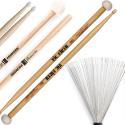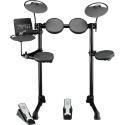Types of Drums Explained: Let's Get Straight To The Point
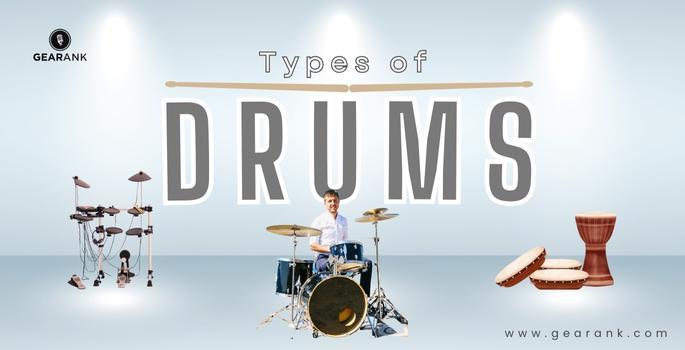
Drums are percussion instruments with a rich history, among the earliest musical instruments used by humanity.
Over time, various types of drums have been developed and refined, creating an array of unique sounds and styles. Almost every culture across the world has its kind of drum.
Nowadays, drums come in all shapes and sizes, including popular acoustic drum kits, percussive drum goblets, modern electronic drums, and many more.
This article explores these drum variants, highlighting their distinct designs, sounds, and the genres of music with which they are typically associated.
But before diving into drum kits and the like, let's learn more about what drums are and discover a little bit about their fascinating history.
What Are Drums?
Drums are a type of percussion instrument commonly known as membranophones.
This name comes from the fact that these musical instruments always have a membrane stretched over the instrument's edges, which can be tightened or loosened to create different tones and affect the resulting percussive sound.
The materials and overall structure of the instrument also play a role in the sound it produces, resulting in a wide range of distinct sounds that are now used in many different genres, musical styles, and cultures.
Drums are used in music and ceremonies, religious or sacred rituals, symbolic gestures, signaling, marching, war, and other activities. But why are drums so widely used?
There are several reasons, the most noteworthy of which are:
-
Accessibility: It is possible to create rhythmic patterns by tapping on solid materials without using drums.
-
Intuitive nature: You only need to focus on the rhythm, not pitch changes.
-
Influence: The beating of drums can evoke emotions, inspire movement, and encourage people to dance.
-
In addition to the above reasons, research shows that drumming positively impacts brain function.
Percussion instruments have been integral to human civilization for centuries. Physical properties like size, shape, and material determine their unique sound qualities.
Beyond music, rhythmic patterns from percussion have cultural, communicative, and therapeutic significance.
With technology, new percussion instruments continue to be created, cementing their importance in music and beyond.
A Brief History Of Drums
The history of drums dates back thousands of years, with its origins in the ancient tribes that used them to create music. The earliest drums had membranes made from animal skin, such as cow, goat, or alligator skin, each producing a unique sound.
The exact origins of this instrument are unclear, but drum artifacts have been found in various ancient civilizations, including China, Greece, Rome, Mesopotamia, and Egypt. This suggests that drums have been played by diverse cultures worldwide.
Scientific evidence shows that both hand drums and drums played with beaters have evolved in parallel. Although the basic structure of drums worldwide has similarities, different cultures have developed their styles and sounds.
Over centuries, drums and drum sticks have evolved, leading to new forms, playing techniques, and sounds. For instance, in the 1920s, drummers used soft brushes to create a softer drumming sound, while the first modern drum kit was invented a decade later.
The first "drum set" was a hybrid instrument that combined various cultures and sounds worldwide. It has since been developed into the acoustic drum set widely used today. However, other distinct drum types still cover a range of performances, from marching music to orchestral setups.
Most Common Drum Sets
It makes sense first to explore drum set types since they are widely used in live performances and recordings.
There are three main drum sets: acoustic drum sets, electronic drum kits, and hybrid drums.
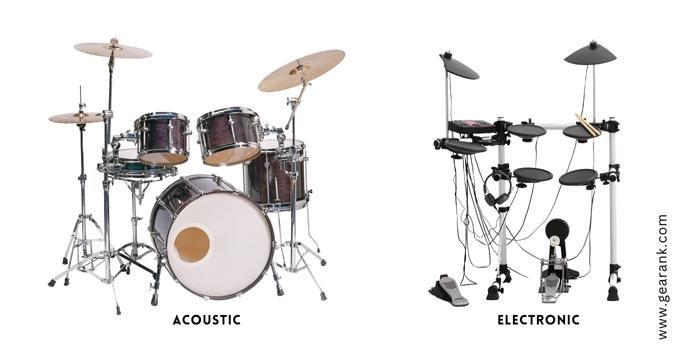
Acoustic Drum Sets
Acoustic drums are among the most popular types of drum kits. They consist of a snare drum, toms, a bass drum, and metal cymbals, creating a dynamic and cohesive sound.
If you want to explore rhythm nuances and subtleties, an acoustic drum kit is the ideal choice.
These drums are composed of several distinct components, including:
-
At the heart of the drum kit lies the Bass Drum, which creates the fundamental low-end rhythm that other musical elements are layered on top of. Together with the bass guitar, it establishes the groove of a song. Bass drums are typically played with a kick pedal or a beater.
-
Tom toms come in different sizes, each fine-tuned to produce unique pitches that add color and texture to rhythms and fills.
-
The Snare Drum produces a sharp crack in the middle register, serving a vital role in establishing rhythmic patterns and backbeats across various genres of music.
-
The Hi-hat is a pair of metal cymbals drummers use for various purposes, such as timekeeping, dynamic control, and accentuation. It is a versatile and expressive component of a drum set, and it is positioned on a hi-hat stand. The stand has a foot controller allowing close, semi-open, and open hi-hat positions.
-
Various types of Bymbals, including crash cymbals, ride cymbals, and splash cymbals, are fashioned from metallic plates. They are designed to produce a high-pitched sound frequently utilized for textural and rhythmic variations in music.
-
Drum hardware includes stands, mounts, and pedals. They keep your drum kit together. Choose the proper hardware to improve sound quality and playing experience.
An acoustic drum set may also incorporate other percussion instruments and effect devices, depending on the drummer's preference and the type of performance.
Several sub-types of acoustic drum kits cater to specific styles, such as rock acoustic drums, fusion acoustic drums, and Jazz acoustic drums.
1. Rock Acoustic Drum Kits
Drums of the acoustic variety typically comprise 18" by 22" bass drums, floor tom, and toms ranging in size from 16" to 12" or 13".
These kits also incorporate snare drums, available in varying dimensions, although most drummers prefer big drum shells at 5.5" by 6" by 14".
Rock drum sets offer the distinct advantage of producing deeper tones, and their larger size is conducive to generating greater volume, making them particularly well-suited to metal and rock music.
2. Fusion Acoustic Drum Sets
Acoustic drum kits incorporating Fusion-style drums feature bass drums measuring 18 inches by 22 inches. The kit can also include drums measuring 14, 13, or 12 inches.
Despite their difference in volume from rock drum kits, Fusion drums offer excellent response times and support rapid technical playing.
3. Jazz Acoustic Drum Sets
The Jazz acoustic drum kit is characterized by its fast response and lightness. It features toms the same size as the Fusion set but with a slightly shallower sound depth due to the smaller bass drum.
In jazz music, drums are not intended to overpower other elements, so size is less of a concern. Instead, a gentler yet complex playing style is typically used.
While other variations of acoustic drum kits are available, the three types mentioned above are the most popular.
Customized hybrid drums may be an excellent option for those seeking a lighter drum set with individual hardware.
Beginners may consider junior drum sets or kiddie drum sets.
Electronic Drum Sets
Electronic drums have revolutionized the world of music. Unlike traditional drum sets that rely on drum heads and metal cymbals, electronic drums use rubber or mesh pads to trigger digital drum sound samples.
These compact and flexible electronic drum pads mimic the positioning of an acoustic drum set and come equipped with pedals for easy control.
Electronic drums' response and sound quality rapidly improve as technology advances. High-end models from industry leaders such as Roland and Yamaha offer exceptional sound quality and performance.
Having recently switched to an electronic drum kit, I can attest to its superior sound quality and ease of use in live situations. It works well with different styles from pop music, to slow tempo balads, to rock, and modern EDM style music.
In addition to improved sound quality and performance, electronic drum kits offer musicians more significant control over volume levels.
Players can play quietly using headphones, making cheap electronic drums sets ideal for practicing and venues where volume control is essential.
Furthermore, electronic drums provide access to a wide range of samples beyond traditional acoustic drum sounds, giving musicians limitless creative possibilities.
Hybrid Drums
Hybrid drums are a fascinating combination of electronic drums and acoustic drum kits, which can be customized in various forms and sizes to suit individual drummers' performance needs.
The most commonly used configuration involves a complete acoustic drum set paired with an electronic drum pad, while others may incorporate pieces of an e-kit into their set to achieve a broader range of sounds. You can mix and match the parts of multiple drums, the end goal of which is having the right combination of percussive sounds needed by your music.
The possibilities for combining different percussion and drum accessories are virtually limitless, allowing drummers to create a kit that perfectly suits their musical style and preferences. You can even add drum machines and traditional frame drums to cover modern and traditional styles.
Marching Drums
Notably, marching drums played a significant role in the evolution of acoustic drums. Acoustic drums are composed of various marching drum instruments.
As the name suggests, Marching drums are membranophones designed explicitly for use in marching. They are typically lightweight and consist of a basic snare, toms, or bass drum with straps for easy carrying.
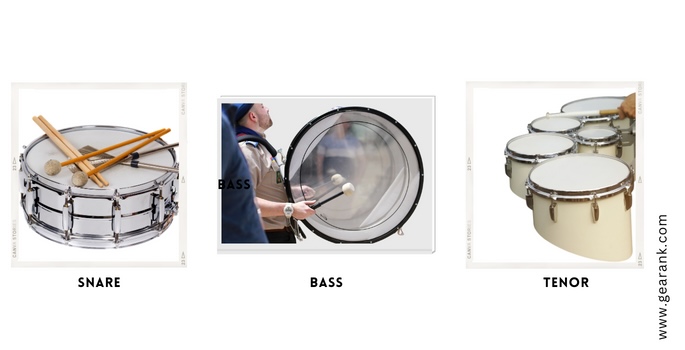
1. Marching Snare Drum
A snare drum designed for movement resembles a drum kit in musical performances. However, its tuning is specific to the demands of marching band music.
The tension of these drums can be adjusted by drummers using a drum key to produce the desired sound for a particular march.
In addition, a marching snare drum features snare wires near the bottom to create the characteristic cracking sound.
2. Marching Bass Drum
The marching bass drum is a percussion instrument that shares similarities with the traditional bass drum on a drum kit. However, it is mounted on a harness attached to the drummer's shoulder to facilitate mobility.
Notably, the marching bass drum is played on both sides, and drummers use bass drum mallets or beaters to strike the left and right membranes following the marching band's rhythm.
The percussion instrument is generally larger and heavier than classical marching snare drums. Therefore, a durable harness is necessary to support its considerable weight.
Moreover, marching drummers must possess considerable strength to carry the heavy drum for extended periods.
The Lambeg drum, which originates from Northern Ireland, is one of the largest types of bass drums, weighing 18 kilograms (40 pounds). As a result, the drummer must wear a neck harness to carry it.
3. Tenor Drum
Marching orchestras are not limited to snare or bass drums but also incorporate tenor drums. Tenor drums produce slightly sharper sounds, like toms on an acoustic drum set.
An ideal multi-tenor drum setup consists of four to six drums of varying sizes, allowing the drummer to manipulate the sound and pitch.
The performance of multi-tenor drum players is the most captivating, as they strike different drums to produce various sounds.
A drum line with several tenor drum players is necessary to achieve an excellent sound from tenor drums. They can play alongside marching band drums to create a harmonious sound.
4. Front Ensemble Drum
Unlike most marching drums, the front ensemble drums are stationary on a sports pitch or bandstand but still fall under marching band drums.
Front ensemble drum setups usually include a drum set, timpani, vibes, bass drums, marimba, and a xylophone.
Hand Drums
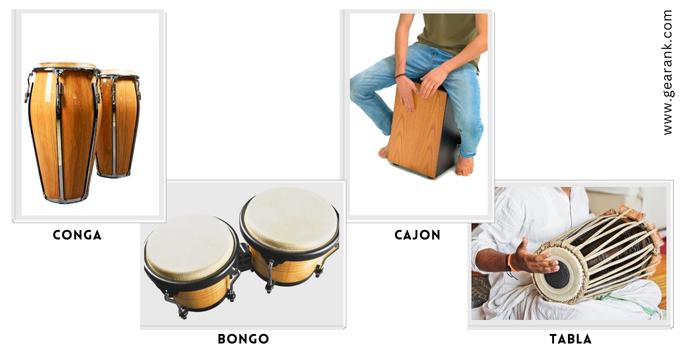
Hand drums are a type of percussion instrument widely used in various cultures across the globe, spanning from South America and Asia to the African continent.
Hand drums can be played using only your hands, unlike other drums requiring sticks or mallets. This makes them a versatile instrument that can be played in various musical settings.
Congas
Congas, also known as tumbadoras, are narrow, tall, single-headed drums originating in Cuba. The name "conga" is derived from the Spanish word for the traditional Cuban carnival.
Typically, congas are played in groups of two or three and can be found in varying sizes. These drums produce deep, resonant tones that are used to add rich and diverse Latin American rhythmic textures to music.
There are three different types of conga drums:
-
Quinto congas, which are the smallest
-
Tres dos congas, which are medium-sized
-
Tumba congas, which are the largest
Bongos
Although congas and bongos may appear similar, there are critical differences between the two types of hand drums. Bongos, for instance, are smaller in size and offer a bright, sharp tone distinct from the deeper, more resonant sound produced by congas.
Despite these differences, however, bongos and congas are often played together, as they are complementary in their sound and can be used to create a rich, layered percussion section.
Both bongos and congas are widely used in Latin American music, including Latin Jazz, bachata, merengue, and salsa. Bongos, in particular, come in various sizes, with larger drums known as the "hembra" and smaller drums called the "macho."
The unique qualities of bongos and congas make them valuable instruments in various musical settings. Their distinct sounds and versatility allow them to be used in solo and ensemble performances, making them popular for musicians of all skill levels.
Tabla Drums
Tabla drums are a percussion instrument that originated in India and Sri Lanka. They are typically played using one's fingers in combination with the heels of the hands.
The drummer can subtly adjust the tension and pitch by applying pressure using the weight of their wrist.
The smaller version of this drum type is known as tabla, while the larger metal drum is called dagga.
Typically, a single drummer plays the small and large tabla drums together. The sound produced is intricate yet expressive, with richer tonality and voicing.
Cajon
The cajon, a contemporary percussion instrument, originates from Peru, where it is commonly used for live acoustic musical performances.
Despite its unusual box-shaped design, it can be equally effective as traditional acoustic drums. This instrument's uniqueness lies in the percussionist's ability to sit on it while playing.
The modern Cajon has undergone modifications to replicate the snare and kick drum sounds produced by conventional drum sets. However, the tonal quality can be altered depending on the playing technique and the instrument's design.
While some drummers prefer playing the Cajon with drumsticks or a brush, it can also be played by striking it with bare hands.
It is important to note, however, that prolonged use of bare hands can result in discomfort and pain, especially among beginners.
Types Of Goblet Drums
I have always been fascinated by the unique shape of goblet-shaped drums.
These drums are primarily found in West Africa, particularly Egypt, where they are part of the traditional Egyptian Shaabi music.
However, goblet-shaped drums are not exclusive to Egypt and can be found in other regions, such as Eastern Europe and South Asia.
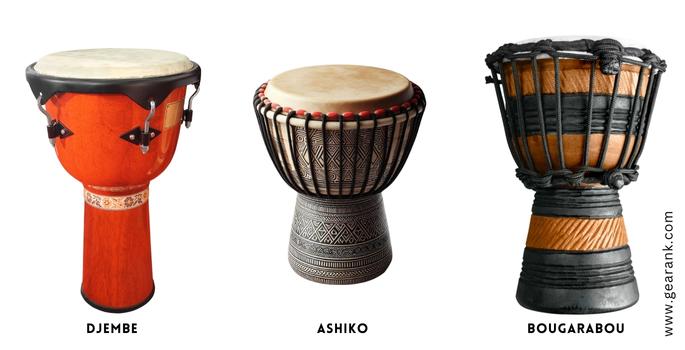
Djembe African Drum
The djembe drum originated in Africa but has gained widespread popularity in Asia and the Western world.
This goblet-shaped drum has a wooden body furnished with a goatskin membrane.
The animal skin is attached to the body with steel rings and a rope. Despite its relatively small size, the African djembe drum can produce a surprisingly loud sound with a volume of up to 105 dB.
The Djembe sound is vibrant, making it an excellent choice for world music applications. The djembe goblet drum has various send depths. Drummers can use it as part of an ensemble or for a solo performance.
By striking the membrane area in different ways with their hands, performers can produce a low pitch (bass), a medium pitch (tone), and a high pitch (slap).
Ashiko
An ashiko drum is characterized by its tapered cylinder shape, with a narrow, open end at the bottom and a wider drum head.
Typically crafted from hardwood and a calfskin membrane, some African tribes may also use goatskin. These drums from Africa are comparable to djembe drums in their ability to generate impressive volume, and they are easily tuned with ropes wrapped around the body.
The ashiko boasts a resonant low end but can also produce a range of pitches, depending on the drummer. In addition, it has a warm, open sound quality that enhances its appeal.
Bougarabou
The bougarabou drum is a widely recognized percussion instrument in West Africa.
Characterized by a conical shape and a single head, these drums are adorned with ropes wrapped around their body. Similar to other goblet drums, bougarabous can serve as tightly tuned accent drums or as part of an ensemble.
Compared to other goblet drums, these instruments are known for their clear melodic elements and wide dynamic range. When played in a group context, the rich overtones bougarabous produce make them easily distinguishable.
Types Of Frame Drums
Frame drums are a type of ancient percussion instrument. They are classified as hand drums and feature a single drumhead made of animal skin.
Despite their simple design, frame drums produce a rich, resonant sound quality. Additionally, their compact size makes them a convenient option for transportation or storage.
These drums are known for their versatility and are used across various musical styles and genres. Due to their straightforward design, frame drums are relatively easy to learn and play.
They are also commonly used for therapeutic or meditative purposes, as their rhythmic patterns can induce a trance-like state.
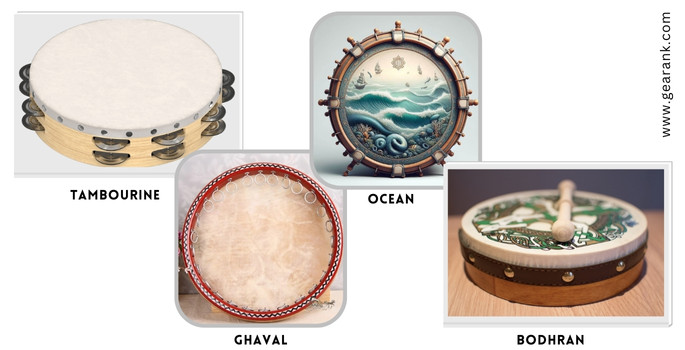
Tambourine
One of the most prevalent hand drums universally is the tambourine. It has various adaptations in diverse cultures worldwide, from Europe to South America. Drummers can use a tambourine to produce a wide range of sounds, making it suitable for various performances, from rock to folk.
The etymology of the word "tambourine" can be traced back to the French word "tambour," which merely means "drum."
Its composition sets the tambourine apart, comprising a drumhead and metal chimes attached to its handheld body. These metallic jingles create a bright, high-pitched sound that contrasts beautifully with the deeper tones produced by the drum membrane.
Playing the tambourine is relatively easy, provided one has a sense of rhythm and a free hand. However, it can produce complex sounds and rhythms in the hands of a professional.
Tambourines are a staple in many different genres of music, from lively church music to modern pop and rock.
Ghaval
The ghaval, a type of drum originating from Azerbaijan, is a component of the frame and drums.
The drumhead of the ghaval produces light jingle sounds and shaking noises, which can be easily played with either hands or knees.
Various types of drums, such as daf and tar drums, have a similar structure to that of the ghaval.
These instruments can be played using a hammer, sticks, fingers, or the palm of your hand.
Bodhran
The bodhran, a small drum originally from Ireland, shares a similar structure with the ghaval.
Typically played with a stick or by hand, the design of frame drums is relatively uniform, with differences in pitch and sound being largely determined by the materials used.
Modern bodhrans may even be equipped with tuners to enhance their sound further. To achieve optimal sound quality, selecting a bodhran made from high-quality materials is as important as tuning it properly.
Ocean Drum
The ocean drum is a unique drum type, notable for its distinct sound. This style of frame drum contains beads within its drumhead that create the sound of ocean currents as they move around when the frame is tilted.
The name 'ocean drum' accurately describes the sound it produces, resembling the rhythmic waves of the ocean.
The ocean drum's exceptional sound enables musicians to create distinctive sound effects as part of a classical music performance or concert.
Utilizing this instrument can add a unique dimension to musical compositions.
Water Drum
Unlike the ocean drum, the Iroquois drum is a unique percussion instrument invented by Native Americans.
The instrument is created by stretching animal skin over a simple water bucket. As the animal skin absorbs moisture from the water, the rawhide changes its tonality and creates unique sound patterns that interest the ear.
The Iroquois drum's distinctive sound is due to the unique tonalities produced by the rawhide as it absorbs moisture, making it a noteworthy instrument in the world of percussion.
Talking Drum
The history of talking drums is a fascinating topic. These hourglass-shaped instruments originated from Africa, where they were used to imitate the sounds of people's ancestors.
The pitch and sound of the talking drum can be altered depending on how it is played. These variations produce a sound akin to the humming or whispering of a person.
Talking drums come in various shapes and sizes, with each ethnic group boasting its unique instrument version. Their dual-sided nature sets these drums apart, which allows for adjustable cord-tightening by squeezing with the arms.
Contemporary Drums
These are a new group of drums inspired by Caribbean instruments. They are gaining popularity in contemporary music.
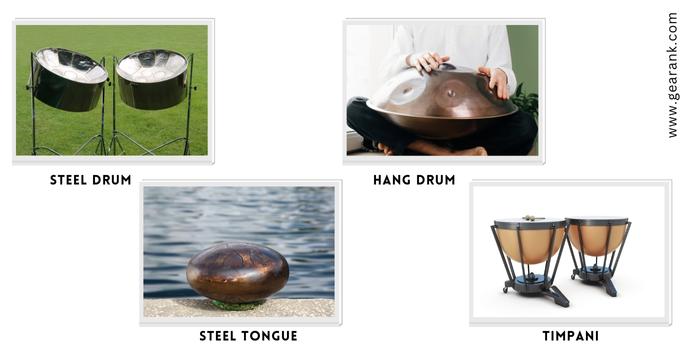
Steel Drums
In recent years, there has been a surge in popularity of a new category of drums made entirely out of metal. The drums possess a distinct eclipse shape that you can easily tap with your fingers or hands to produce a unique sound.
Steelpans, the origin of these drums, hail from the Caribbean, where they are commonly found in bars or on beaches. Steel drums have become increasingly popular, even in other music genres, such as pop, rock, and classical.
One of the most significant advantages of these drums is their ease of use. They are made on a single scale, which makes them incredibly simple to play. Moreover, you can hit them anywhere and always produce a good sound.
I found them great fun, but they also limit what songs you can play.
Hang Drums and Handpans
Hang drums are a relatively new musical instrument designed and produced by the Swiss company PANArt. Although the company did not initially use the term "Hang drum" to describe its product, the name caught on with users and has since become widely accepted.
A hang drum, also called a handpan, shares the same basic design.
The structure of hang drums and handpans is a metallic bowl, with various parts of the instrument tuned to specific pitches. The notes are played by tapping different surface areas, meaning each handpan is limited to the particular scale for which it was created.
When played by skilled musicians, the sound of a handpan is quite magical, resembling that of a resonant harp with percussive elements.
Following the release of PANArt's drum in 2000, other instrument makers began producing similar designs, now known as handpans. However, since handpans are always handmade, they are relatively expensive, with some models costing thousands of dollars.
As such, it is crucial for prospective buyers to carefully consider their options and ensure that they are purchasing an instrument from a reputable source.
Steel Tongue Drums
Steel tongue drums, a type of steel drum, are smaller and less expensive than traditional handpans.
Despite their differences, they produce a similar sound to a handpan. Modern steel drums are now equipped with tuning magnets and built-in microphones.
If you are interested in these instruments' unique melodic and percussive sounds, a steel tongue drum can serve as an excellent introduction to handpans.
Timpani Drum
The timpani is distinct from traditional drums, yet it is a common feature in orchestral arrangements. The instrument's weight is substantial, requiring a large drumhead that can be tuned using a pedal.
Due to its size, playing and tuning the timpani requires exceptional skill, so timpanists are often compensated more than other musicians in an orchestra. Because of the timpani's tuned nature, it is different from a concert bass drum, which is used mostly for rhythm and percussion.
Despite the challenges, the timpani (also called kettle drums) produces a remarkable sound suitable for creating special effects such as thunder. The instrument can also be used to produce regular drum rolls as required.
Final Thoughts
Drums, as percussion instruments, are found in various forms worldwide, each with their unique purpose.
The diversity in their construction materials and sizes results in different sound patterns, such as deep tones, sharp cracks, and even scales.
While some drums are easily accessible and commonly used, others are reserved for professionals who dedicate their lives to studying and performing music.
From modern drum kits to traditional bongo drums from West Africa, the many different types of drums worldwide all present unique characteristics and styles.
Which types of drums do you prefer?
Frequently Asked Questions
Who Invented The Drum?
The invention of drums resulted from contributions by various cultures and tribes and cannot be attributed to a single individual. As such, music historians credit the evolution of drums to a collective effort that has given rise to the vast range of drums we have today.
What Are Four Types Of African Drums?
African drumming is a rich and diverse tradition, with various instruments played throughout the continent. Among the most widely recognized are the djembe, ashiko, bougarabou, and bata. However, countless other drums have unique sounds and cultural significance.
What Type Of Drum Is Easier To Play?
Hand drums and frame drums are instruments ideal for novices seeking to learn the basics of drumming. However, it's essential to be mindful that excessive use of these instruments can cause discomfort and pain to the hands, particularly for those new to the art.
What Is The Biggest Drum Called?
The biggest single-headed drum is the timpani, which is part of the classical orchestra setup.
There are even bigger drum setups, like the Mark Temperato drum set, made of an incredible 815 pieces.
Contributors:
- Jerry Borillo - Illustrator



